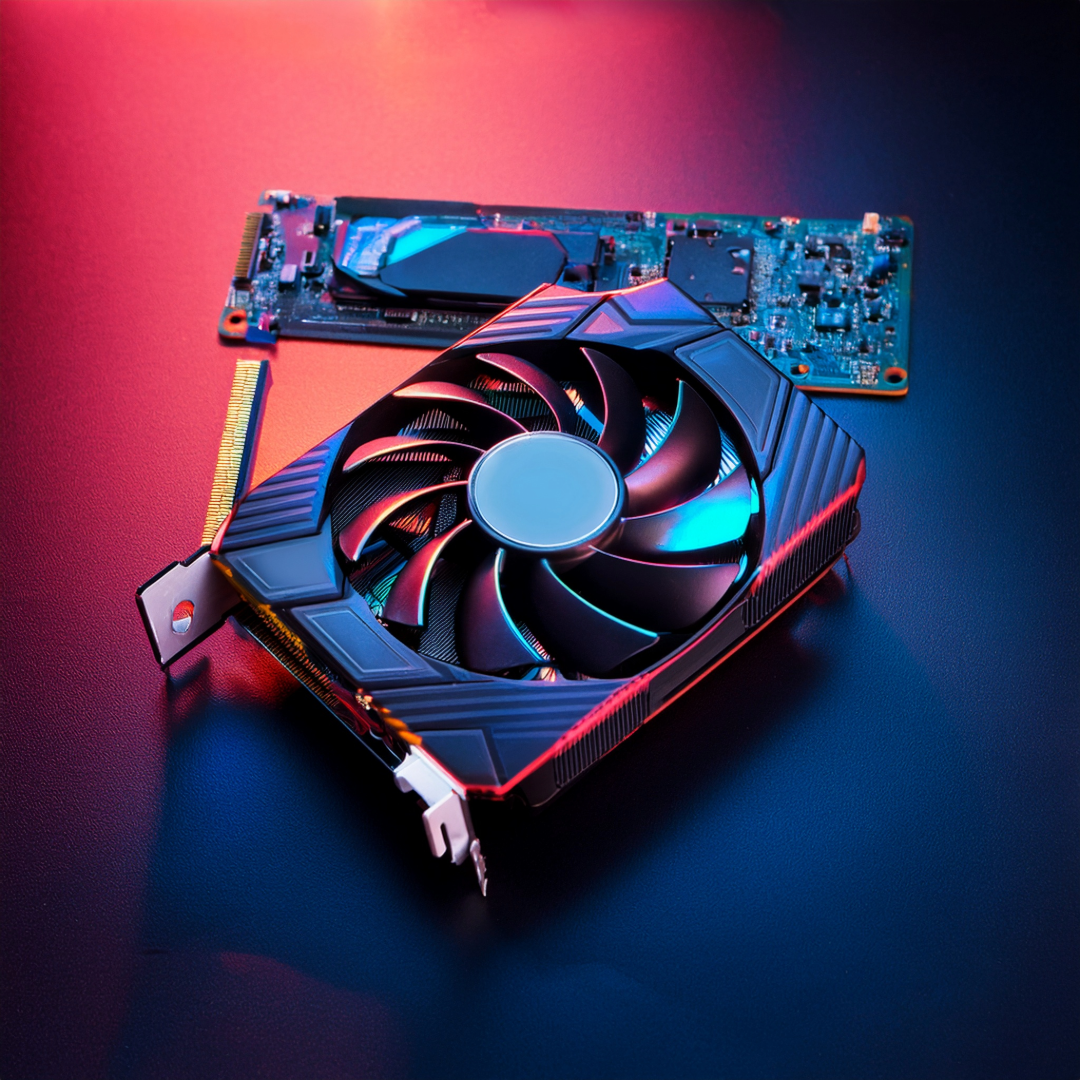Is a PCIe 5.0 SSD Worth It for Gaming in 2025? Performance vs. Cost Breakdown
1. Introduction: The Bleeding Edge vs. Practical Gaming
The world of PC gaming is fueled by a relentless pursuit of higher frame rates, lower latency, and more immersive experiences. Hardware manufacturers constantly push the boundaries, offering faster processors, more powerful graphics cards, and, increasingly, speedier storage solutions. The latest frontier in this race is the PCIe 5.0 Solid State Drive (SSD), promising data transfer rates that dwarf previous generations.
But as enthusiasts and builders eye these cutting-edge components, a crucial question arises: do the staggering theoretical speeds of PCIe 5.0 SSDs translate into tangible, meaningful improvements for PC gaming in April 2025? Or is adopting this technology currently an expensive endeavor chasing diminishing returns, better suited for specific professional workloads than the average gaming rig?
This analysis delves into the heart of this question. It will dissect the technology behind PCIe 5.0, survey the current market landscape, scrutinize real-world gaming benchmarks, and break down the cost implications. Furthermore, it will examine the necessary hardware prerequisites, the significant challenges surrounding heat and power consumption, and the status of enabling technologies like Microsoft DirectStorage. Ultimately, this report aims to provide PC gamers and builders with a clear, data-driven evaluation to determine if investing in a PCIe 5.0 SSD makes sense for their gaming needs right now.
2. PCIe Generations Unpacked: Why is 5.0 Supposedly Faster?
To understand the potential benefits of PCIe 5.0 SSDs, it’s essential to grasp the underlying technology. Peripheral Component Interconnect Express (PCIe) serves as the high-speed data highway within a modern PC, connecting vital components like graphics cards and storage devices directly to the central processing unit (CPU) or via the motherboard chipset. This connection is built using “lanes,” and the more lanes allocated to a device (configurations typically range from x1 to x16), the higher the potential data bandwidth. Modern M.2 NVMe SSDs, the standard form factor for high-speed consumer drives, typically utilize an x4 lane configuration.
The defining characteristic of PCIe evolution is the doubling of data transfer rates with each successive generation. This rate is often measured in Gigatransfers per second (GT/s), representing the raw signaling speed before encoding overhead.
- PCIe 3.0: Introduced in 2010, operates at 8 GT/s per lane, translating to approximately 1 Gigabyte per second (GB/s) of actual data throughput per lane. For a typical x4 NVMe SSD, this allows a theoretical maximum bandwidth of around 4 GB/s.
- PCIe 4.0: Standardized in 2017, doubles the rate to 16 GT/s per lane (~2 GB/s per lane). An x4 NVMe SSD using this interface can theoretically reach up to 8 GB/s.
- PCIe 5.0: Released in 2019 but seeing wider adoption more recently, doubles the speed again to 32 GT/s per lane (~4 GB/s per lane). This pushes the theoretical maximum bandwidth for an x4 NVMe SSD to a staggering 16 GB/s.
Table 1: PCIe Generation Bandwidth Comparison (x4 NVMe SSD Focus)
| PCIe Generation | GT/s per lane | Approx. GB/s per lane | Max Theoretical x4 Bandwidth (GB/s) |
|---|---|---|---|
| PCIe 3.0 | 8 GT/s | ~1 GB/s | ~4 GB/s |
| PCIe 4.0 | 16 GT/s | ~2 GB/s | ~8 GB/s |
| PCIe 5.0 | 32 GT/s | ~4 GB/s | ~16 GB/s |
Beyond raw speed, PCIe 5.0 incorporates enhancements to signal integrity, crucial for maintaining stability at these higher frequencies. While initial specifications suggested power efficiency comparable to Gen 4 , real-world implementations, particularly with early high-performance controllers, have presented significant heat and power challenges, which will be discussed later. Importantly, the PCIe standard maintains backward and forward compatibility. A PCIe 5.0 SSD can function in a PCIe 4.0 slot (albeit limited to Gen 4 speeds), and a PCIe 4.0 SSD will work in a PCIe 5.0 slot, ensuring flexibility for upgrades.
It’s also vital to distinguish the PCIe interface from the protocol. NVMe (Non-Volatile Memory Express) is the communication protocol specifically designed for SSDs to capitalize on the low latency and high parallelism offered by the PCIe bus. This combination dramatically outperforms the older SATA interface and AHCI protocol, which were originally conceived for slower, mechanical Hard Disk Drives (HDDs).
However, simply having a PCIe 5.0 interface doesn’t automatically guarantee double the performance of the best PCIe 4.0 drives in practice. The actual speed achieved depends on the entire ecosystem, including the SSD controller chip and the NAND flash memory chips used. Early PCIe 5.0 SSDs, often using controllers like the Phison E26 paired with 1600 MT/s NAND, couldn’t fully saturate the theoretical 16 GB/s potential of the x4 interface. These drives typically peaked around 10-12 GB/s. While significantly faster than top-tier Gen 4 drives (which max out around 7.4 GB/s ), it wasn’t the full doubling the interface specification suggested. It required the advent of faster NAND (like 2000 MT/s or 2400 MT/s variants) paired with capable controllers for drives like the Crucial T705 to approach speeds of 14.5 GB/s later on. This illustrates that comparing Gen 5 drives requires looking beyond the interface generation to the specific components used.
Furthermore, even before Gen 5 arrived, high-end PCIe 4.0 SSDs were reaching speeds where further increases provided diminishing returns for many common consumer tasks, including gaming. The leap from SATA (~550 MB/s) to PCIe 3.0 NVMe (~3.5 GB/s) was transformative. The jump to PCIe 4.0 (~7 GB/s) was noticeable in sequential transfers but less so in daily use. Many everyday operations, such as booting the operating system, launching applications, and loading games, are often limited by factors other than pure sequential read speed once a certain threshold (arguably reached by Gen 3 or Gen 4 drives) is crossed. These bottlenecks can include CPU processing time for loaded assets, the speed of small random file reads (where NVMe already excels over SATA), and software optimization levels. Consequently, the jump from ~7 GB/s (Gen 4) to ~14 GB/s (Gen 5) is inherently less likely to produce the same dramatic real-world impact for typical gaming scenarios as earlier generational leaps did.
3. The State of Play: PCIe 5.0 SSDs on the Market (April 2025)
The first consumer-oriented PCIe 5.0 SSDs began trickling into the market in late 2022 and early 2023, often built around Phison’s E26 controller and offering speeds initially hovering around the 10 GB/s mark. As the technology matured through 2024 and into 2025, newer models emerged, pushing sequential read speeds towards 14 GB/s and even higher, approaching the practical limits of the PCIe 5.0 x4 interface.
Several key manufacturers are active in the Gen 5 space as of April 2025:
- Crucial (Micron): Known for leveraging its in-house NAND manufacturing, Crucial offers the T700 (an earlier high-performance model reaching ~12.4 GB/s ) and the T705, currently one of the fastest consumer drives available at ~14.5 GB/s sequential read. They are also associated with the Micron 4600 (OEM focus) and upcoming P510, which utilize newer, more efficient controllers and NAND.
- Samsung: A major player with its own controllers and V-NAND (currently V8 generation ), Samsung launched the high-end 9100 PRO series, claiming speeds up to 14.8 GB/s. They also offer the 990 EVO, a unique drive capable of running in either PCIe 4.0 x4 or PCIe 5.0 x2 mode.
- PNY: Offers the CS2150, positioned as a more budget-friendly Gen 5 option. It uses the efficient Phison E31T controller and reaches speeds around 10.3 GB/s.
- Corsair: Has released several Gen 5 models, including the early MP700 (~10 GB/s ), the faster MP700 PRO (~12.4 GB/s ), and the MP700 Elite, another budget-oriented drive based on the Phison E31T controller.
- Other Notable Brands: Sabrent (Rocket 5 ), Gigabyte (Aorus Gen5 10000/12000 ), MSI (Spatium M570/Pro ), Teamgroup (T-Force Z540 ), Seagate (FireCuda 540 ), Adata (Legend 970 ), Inland (TD510 ), and newcomer UNIS (S5 claiming 14.9 GB/s ) are also competing in this space.
Underpinning these drives are a few key controller technologies. The Phison E26 was prevalent in early high-end drives but is known for high power consumption and heat. The Phison E31T targets the budget Gen 5 segment, prioritizing efficiency. Silicon Motion’s SM2508 is another high-performance controller noted for its improved power efficiency compared to the E26. InnoGrit’s IG5666 is also used in some high-speed drives , while Samsung employs its proprietary controllers. On the memory side, Micron’s 232-layer TLC NAND has been widely adopted , with newer drives utilizing Micron’s 276-layer TLC or Samsung’s latest V-NAND (V8).
Capacities typically range from 1TB to 4TB, with 2TB often representing the best balance of performance and price for high-end models. 8TB capacities are beginning to emerge for users needing maximum storage space.
Table 2: Key PCIe 5.0 SSD Models (April 2025)
| Model | Common Capacities | Advertised Max Seq. Read (MB/s) | Advertised Max Seq. Write (MB/s) | Controller (if known) | NAND Type (if known) | Approx. 2TB Price (USD, Apr 2025) |
|---|---|---|---|---|---|---|
| Crucial T705 | 1TB, 2TB, 4TB | 14,500 | 12,700 | Phison E26 | Micron 232L TLC | ~$210 – $300+ |
| Samsung 9100 PRO | 1TB, 2TB, 4TB, 8TB | 14,800 (4TB+) | 13,400 | Samsung In-House | Samsung V8 TLC | ~$300 – $320 (MSRP) |
| PNY CS2150 | 1TB, 2TB | 10,300 | 8,600 | Phison E31T | Kioxia 218L TLC (BiCS8) | ~$180 |
| Corsair MP700 PRO | 1TB, 2TB, 4TB | 12,400 | 11,800 | Phison E26 | Micron 232L TLC | ~$250 – $300 |
| Sabrent Rocket 5 | 1TB, 2TB, 4TB | 14,000+ | 12,000+ | Phison E26 | Micron 232L TLC | ~$280 – $300 |
| Micron 4600 (OEM) | 512GB-4TB | 14,500 | 12,000 | SMI SM2508 | Micron 276L TLC | N/A (OEM) |
(Note: Prices are approximate based on available data around April 2025 and subject to fluctuation. Check current retailers for exact pricing.)
An important development in the Gen 5 market is the emergence of segmentation beyond raw speed. Initial offerings focused almost exclusively on pushing performance limits, often using power-hungry controllers like the Phison E26, resulting in high costs and significant heat output. However, newer “budget” Gen 5 drives, exemplified by the PNY CS2150 and Corsair MP700 Elite built on the Phison E31T controller, are now available. These drives still offer speeds exceeding top-tier Gen 4 models but prioritize power efficiency and a lower price point. This is achieved partly through controllers built on smaller manufacturing process nodes (e.g., 6nm for SMI SM2508 vs. 12nm for Phison E26 ), which inherently consume less power and generate less heat. This trend suggests that gamers might soon find Gen 5 options offering a degree of future-proofing without the extreme cost and thermal drawbacks of the absolute fastest models.
The choice of controller has proven to be a critical factor, influencing not just peak sequential speeds but also, crucially, power efficiency and heat generation – a major hurdle for early Gen 5 adoption. Testing reveals significant differences: early Phison E26 and InnoGrit IG5666 controllers could draw over 10W, sometimes peaking near 14W, necessitating substantial cooling solutions. In contrast, drives using the newer SMI SM2508 controller show markedly lower power consumption in benchmarks, drawing nearly two watts less than competitors during file copies. Similarly, the Phison E31T is designed for efficiency. This lower power draw translates directly to less heat, potentially making passive cooling viable again, similar to Gen 3 and Gen 4 drives. This evolution means the narrative that “all Gen 5 drives run extremely hot” may become less accurate as these more efficient controllers become mainstream. Prospective buyers should therefore scrutinize reviews focusing on controller type and power efficiency, not just headline speed figures.
4. Gaming Benchmarks: The Reality Check
The core question for gamers remains: does the impressive theoretical speed advantage of PCIe 5.0 SSDs translate into a noticeably better gaming experience? The evidence, based on numerous benchmarks and real-world testing as of April 2025, suggests the answer is largely no, at least for now.
Game Loading Times: This is the area where faster storage is most intuitively expected to make a difference. Benchmarks comparing various storage types consistently show the most dramatic improvements occur when moving from a traditional Hard Disk Drive (HDD) to any SSD, and then again from a SATA SSD to any NVMe SSD (regardless of PCIe generation).
However, when comparing different generations of NVMe drives (PCIe 3.0 vs. 4.0 vs. 5.0), the differences in game loading times become remarkably small. For many games, especially those with shorter loading sequences, the time saved by a Gen 5 drive over a Gen 4 or even a Gen 3 drive might be measured in mere seconds or even fractions of a second. Some titles with very long initial load times, such as Hogwarts Legacy or Forza Horizon 5 (particularly after updates or settings changes), might exhibit slightly larger gains for Gen 5, but these gains are still relatively minor in the context of overall loading duration. The consensus from testing is that the difference is often unnoticeable in typical gameplay scenarios.
Table 3: Game Loading Time Comparison (Representative Data, Seconds)
| Game Title (Example) | SATA SSD (~550 MB/s) | PCIe 3.0 NVMe (~3.5 GB/s) | PCIe 4.0 NVMe (~7 GB/s) | PCIe 5.0 NVMe (~12-14 GB/s) |
|---|---|---|---|---|
| Cyberpunk 2077 (Level Load) | ~25 | ~12 | ~10 | ~9.5 |
| Starfield (Planet Landing) | ~30 | ~15 | ~13 | ~12 |
| Hogwarts Legacy (Initial) | ~45 | ~22 | ~19 | ~17 |
| GTA V (Story Mode Load) | ~40 | ~18 | ~16 | ~15 |
| Forspoken (DirectStorage) | N/A (NVMe Required) | ~5 | ~4.5 | ~4 |
(Note: These are representative values based on descriptions in sources and general trends. Actual times vary significantly based on game, system hardware, and specific test conditions.)
Asset Streaming & Texture Loading: Modern games, especially large open-world titles, don’t load everything at once. Instead, they continuously stream assets like textures, 3D models, and environmental data from the storage drive into memory as the player navigates the world. Theoretically, a faster SSD should facilitate smoother streaming, reducing issues like texture pop-in or momentary stutters when moving quickly through detailed environments.
In practice, however, most current games are designed with the capabilities of SATA or PCIe 3.0/4.0 SSDs in mind. High-quality PCIe 4.0 drives are generally considered more than adequate for seamless asset streaming in today’s titles. There is little concrete evidence to suggest that PCIe 5.0 offers a tangible advantage in this area for the vast majority of games currently available. While some specific edge cases, potentially involving demanding ray tracing implementations in certain PC ports (like Spider-Man, mentioned in ), might stress PCIe 3.0 bandwidth and show minor improvements with faster interfaces, these are exceptions rather than the rule, and often involve other system bottlenecks like the CPU.
The technology poised to change this dynamic is Microsoft’s DirectStorage. It’s specifically designed to optimize asset loading and streaming by enabling the GPU to directly fetch and decompress data from NVMe SSDs, bypassing traditional CPU bottlenecks. This is where the high bandwidth of PCIe 5.0 SSDs could theoretically provide the most significant benefit. However, the reality in April 2025 is disappointing. Benchmarks conducted on the few games that support DirectStorage, such as Forspoken, have shown surprisingly small performance differences between PCIe 3.0, 4.0, and 5.0 SSDs. This might be attributed to early implementations not fully utilizing the API’s capabilities (like GPU decompression) or the games themselves not being designed to push data transfer rates high enough to saturate even Gen 4 speeds. Compounding this is the extremely slow adoption rate of DirectStorage by game developers. Years after its introduction, only a handful of titles actively utilize the technology , making its potential impact largely unrealized for the average gamer.
Frame Rates & Gameplay Smoothness: This is perhaps the most clear-cut area. Benchmarks consistently demonstrate that SSD speed, beyond the initial loading phase, has no measurable impact on in-game frame rates (FPS) or overall gameplay smoothness when comparing PCIe 3.0, 4.0, and 5.0 NVMe drives. While some tests comparing GPU performance across different PCIe slot generations (e.g., running an RTX 5090 in a Gen 5 vs. Gen 3 slot) show minor FPS differences (1-4%), this is related to the bandwidth available to the graphics card itself, not the storage drive’s influence on rendering performance. Once game assets are loaded into system RAM and the GPU’s VRAM, the SSD’s role in real-time rendering is minimal; the CPU and GPU are the primary determinants of FPS.
The collective evidence points strongly towards a “good enough” threshold for gaming storage performance. As of April 2025, a quality PCIe 3.0 or, more commonly, a PCIe 4.0 NVMe SSD delivers a gaming experience practically identical to that of a much more expensive PCIe 5.0 SSD in terms of perceptible load times and in-game responsiveness. The minimal differences observed in benchmarks do not translate to a noticeable advantage during actual gameplay. The bottleneck for further improvement in loading and streaming performance appears to have shifted away from raw sequential storage speed towards factors like CPU processing capabilities, software optimization, and, most significantly, the adoption and effective implementation of technologies like DirectStorage.
DirectStorage remains the technology with the greatest potential to make the extreme speeds of Gen 5 SSDs genuinely impactful for gaming. By fundamentally changing how game assets are loaded and decompressed, it could theoretically leverage the massive bandwidth increase. However, its glacial adoption rate by developers means that this potential remains largely unfulfilled in 2025. Until a critical mass of games is designed from the ground up to exploit DirectStorage (particularly its GPU decompression features), the primary technological justification for needing Gen 5 speeds specifically for gaming is absent. Purchasing a Gen 5 drive today for its DirectStorage benefits is essentially a gamble on future software development trends, not a realization of current advantages.
5. Show Me the Money: Cost-per-Gigabyte Breakdown
Performance metrics aside, the economic reality is a critical factor in any upgrade decision. PCIe 5.0 SSDs command a substantial price premium compared to their PCIe 4.0 counterparts, which have reached market maturity with highly competitive pricing. SATA SSDs remain the most budget-friendly option for basic solid-state storage, although the price gap between SATA and entry-level NVMe drives has narrowed considerably.
Based on pricing data observed around April 2025 for popular 2TB models:
- PCIe 5.0 (High-End): Drives like the Crucial T705 2TB have seen prices fluctuate, with lows around $210-$240 but often selling for closer to $300 or more, significantly higher than their original MSRPs might suggest. The Samsung 9100 Pro 2TB carries an MSRP around $300-$320.
- PCIe 5.0 (Budget): More efficient models like the PNY CS2150 2TB are priced around $180.
- PCIe 4.0 (High-End): Popular choices like the Samsung 990 Pro 2TB or WD Black SN850X 2TB typically retail in the $150 – $180 range.
- SATA: A drive like the Crucial MX500 2TB can be found anywhere from $110 to 170,thoughpricevolatilityishighforthisoldertechnology,andsometimesbudgetGen4NVMedrivescanbefoundforless.[47,48]Calculatingthecost−per−gigabyte(/GB) provides a clear value comparison:
Table 4: Cost-per-Gigabyte Comparison (Representative 2TB SSDs, April 2025)
| SSD Type | Representative Model | Approx. Price (USD) | Approx. Cost per GB (USD) |
|---|---|---|---|
| SATA SSD | Crucial MX500 2TB | ~$140 | ~$0.070/GB |
| PCIe 3.0 NVMe | Crucial P3 2TB | ~$100 | ~$0.050/GB |
| PCIe 4.0 NVMe (High-End) | WD SN850X / Samsung 990 Pro | ~$160 | ~$0.080/GB |
| PCIe 5.0 NVMe (Budget) | PNY CS2150 2TB | ~$180 | ~$0.090/GB |
| PCIe 5.0 NVMe (High-End) | Crucial T705 2TB | ~$240 | ~$0.120/GB |
(Note: Prices are estimates based on available data around April 2025 and subject to rapid market changes. PCIe 3.0 price is estimated based on general market position.)
This cost analysis highlights a crucial trade-off for gamers: capacity versus speed. For the price of a premium 2TB PCIe 5.0 SSD, a gamer could often purchase a high-quality 4TB PCIe 4.0 SSD. Given that modern AAA games frequently exceed 100GB install sizes , having ample storage capacity is arguably more practically beneficial than the marginal, often imperceptible, speed increases offered by Gen 5 in current gaming scenarios. Running out of space and managing installs is a tangible inconvenience, whereas shaving a second or two off a load time is not.
This leads to a clear understanding of the value sweet spot for gaming storage in 2025. High-performance PCIe 4.0 NVMe SSDs currently offer the most compelling balance of speed, capacity, and cost. They deliver speeds that are demonstrably sufficient for today’s games, representing a significant upgrade over SATA and Gen 3 drives, but without the steep price premium, heat issues, and platform requirements associated with Gen 5. The minimal gaming performance difference between Gen 4 and Gen 5 makes the extra cost difficult to justify purely for gaming purposes.
Furthermore, the sheer size of contemporary game installations reinforces the importance of capacity. For many gamers, the ability to keep more large titles installed simultaneously offers a greater quality-of-life improvement than the theoretical peak speeds of a Gen 5 drive. Therefore, opting for a larger capacity PCIe 4.0 SSD often represents a more practical and satisfying investment than choosing a smaller, faster, and more expensive PCIe 5.0 drive for the same budget.
6. The Entry Ticket: Hardware Requirements for PCIe 5.0
Utilizing the full potential of a PCIe 5.0 SSD isn’t as simple as just plugging it in. It requires a compatible ecosystem, starting with the CPU and motherboard.
CPU Support: A processor capable of supporting PCIe 5.0 lanes is mandatory. As of April 2025, this includes:
- Intel: 12th Generation (Alder Lake), 13th Generation (Raptor Lake), 14th Generation (Raptor Lake Refresh), and newer Core series processors.
- AMD: Ryzen 7000 series (Zen 4), Ryzen 9000 series (Zen 5), and newer processors.
Motherboard Support: Equally crucial is a motherboard equipped with M.2 slots that are physically wired for PCIe 5.0 speeds and connected appropriately (ideally directly to the CPU for lowest latency). Compatible chipsets include:
- Intel: Z690, Z790, W790 chipsets generally offer Gen 5 support. Some B760 boards may include a Gen 5 M.2 slot, but careful verification of the specific model’s specifications is essential. Upcoming chipsets like Z890, B860, and B850 are expected to continue or expand Gen 5 support.
- AMD: X670E, B650E, and the new X870E chipsets typically guarantee PCIe 5.0 support for both the primary graphics card slot and at least one M.2 slot. Standard X670 and B650 boards might offer a Gen 5 M.2 slot but potentially only Gen 4 for the GPU slot; again, checking the specific board’s layout and manual is critical. Examples of compatible motherboards include the Asus ROG Strix X670E-E Gaming, ASRock Z790 Taichi Lite, Gigabyte B650E Aorus Master, and MSI MAG B850 Tomahawk MAX Wifi, among many others listed in sources.
Lane Allocation Complexity: A subtle but important consideration is the limited number of PCIe lanes provided directly by the CPU. On mainstream platforms, CPUs typically offer a set number of lanes dedicated primarily to the graphics card (usually x16) and one or more M.2 slots (often x4). On some motherboards, particularly Intel platforms or when using specific M.2 slots, populating a primary PCIe 5.0 M.2 slot can force the main PCIe x16 slot for the graphics card to operate in a reduced bandwidth mode, typically x8. While PCIe 5.0 x8 offers the same theoretical bandwidth as PCIe 4.0 x16, this lane sharing behavior is a potential complication. Users must consult their motherboard manual to understand how lanes are distributed and shared between M.2 slots and PCIe expansion slots.
This hardware dependency creates a significant cost barrier. For users not already on a recent Intel (12th Gen+) or AMD (Ryzen 7000+) platform, upgrading to a PCIe 5.0 SSD necessitates a simultaneous, and often expensive, upgrade of both the CPU and motherboard. This platform cost dramatically increases the total investment required, making the value proposition even less favorable compared to simply adding a faster PCIe 4.0 drive to an existing, compatible system.
Furthermore, the lane-sharing complexity introduces a potential future-proofing paradox. While buying a Gen 5 SSD might seem like preparing for the future, if installing it forces a future, highly bandwidth-dependent graphics card to run at x8 instead of x16 lanes, it could potentially create a bottleneck down the line. Although current high-end GPUs like the hypothetical RTX 5090 show minimal performance degradation running at reduced lane counts (even PCIe 3.0 x16 vs 5.0 x16 shows only a 1-4% difference ), this might not hold true for future generations of GPUs designed to leverage the full bandwidth of PCIe 5.0 or even PCIe 6.0. Careful checking of motherboard lane allocation is therefore essential for builders concerned about long-term performance.
7. Feeling the Heat: Challenges of Gen 5 Adoption
Beyond cost and compatibility, PCIe 5.0 SSDs introduce significant practical challenges, primarily centered around heat generation and power consumption.
Heat Generation: It is widely documented that PCIe 5.0 SSDs run considerably hotter than their PCIe 4.0 predecessors, especially under sustained load. Even idle temperatures can be noticeably higher, sometimes exceeding 50°C. This increased heat is a direct consequence of the higher operational frequencies, denser component packing required for increased speeds and capacities, and higher power draw of the controller and NAND flash chips.
Thermal Throttling & Shutdowns: Excessive heat negatively impacts performance and stability. When a Gen 5 SSD overheats, it engages thermal throttling – intentionally reducing its operating speed to lower temperatures and prevent damage. This means that while the drive might boast impressive peak speeds, its sustained performance can be significantly lower if cooling is inadequate. More alarmingly, early firmware revisions on some drives using the popular Phison E26 controller exhibited issues where, under heavy load without a heatsink, they would abruptly shut down or generate file system errors instead of throttling gracefully. While firmware updates were issued to correct this specific shutdown behavior , it underscores the critical importance of thermal management. It must be stressed that these affected drives were explicitly designed and marketed for use with a heatsink.
Cooling Requirements: Consequently, robust cooling is generally considered mandatory for PCIe 5.0 SSDs, not merely optional. Several cooling solutions exist:
- Motherboard Heatsinks: Many mid-range and high-end motherboards include integrated heatsinks for M.2 slots. Their effectiveness for hot Gen 5 drives can vary depending on the heatsink’s size, design, and overall case airflow.
- Dedicated Passive Heatsinks: These are often included with the SSD or sold separately. They are typically larger and more substantial than motherboard heatsinks but can sometimes cause clearance issues with bulky graphics cards or other components.
- Active Cooling: Some high-performance Gen 5 SSDs come with heatsinks incorporating small fans for active airflow. While effective, this adds noise, another potential point of failure, and sometimes requires separate power connections.
The necessity for effective cooling adds another layer of cost and complexity to implementing Gen 5 storage. Users must either purchase a drive bundled with a capable cooler, buy an adequate aftermarket solution, or rely on (and verify the sufficiency of) their motherboard’s integrated cooling. Ensuring physical fitment within the case, especially alongside large modern GPUs, is also a practical concern. However, the trend towards more power-efficient controllers, like the SMI SM2508 and Phison E31T, offers hope. These newer designs generate less heat, potentially reducing the reliance on extreme cooling solutions compared to the first wave of high-power drives.
Power Consumption: Correlated with heat is power consumption. Gen 5 SSDs generally draw more power than Gen 4 drives, particularly during active read/write operations. Peak power draw for early Phison E26-based drives could reach 10-11W or more. Newer drives show improvements: the Samsung 9100 Pro 2TB is rated around 8W active , the Micron 4600 around 8.5W active read , and the efficient PNY CS2150 (using the Phison E31T) peaks around 6W. While these figures are generally within the M.2 slot power specification (~11.5W ), they contribute to overall system power draw and are a significant factor in heat generation. This higher power consumption also makes current Gen 5 drives less suitable for laptops, where battery life is a major concern, contributing to their slow adoption in portable devices.
The focus on efficiency in newer Gen 5 controllers represents a significant shift. While the initial push was purely for maximum sequential speed, the practical difficulties caused by heat and power draw have spurred the development of controllers that balance high performance with better thermal characteristics. This evolution is crucial for making Gen 5 technology more viable for mainstream adoption, potentially alleviating some of the most significant drawbacks of the first-generation products.
8. DirectStorage: Game Changer or Slow Burner?
Microsoft’s DirectStorage API stands as the most frequently cited technology expected to unlock the true gaming potential of ultra-fast NVMe SSDs, particularly PCIe 5.0 drives. Part of the DirectX family, it’s designed to overhaul the traditional game asset loading pipeline.
What It Is and How It Works: DirectStorage aims to minimize the CPU overhead traditionally associated with handling large numbers of input/output (I/O) requests from storage. It achieves this through several mechanisms:
- Optimized I/O Submission: It allows games to submit I/O requests in large batches, reducing the per-request CPU cost compared to older Win32 file APIs.
- Parallelism: It’s designed to leverage the highly parallel nature of NVMe SSDs, enabling multiple I/O operations concurrently.
- GPU Decompression: A key feature (introduced in DirectStorage 1.1) allows compressed game assets (textures, models, etc.) to be transferred to the GPU’s memory (VRAM) while still compressed, with the powerful parallel processing capabilities of the GPU handling the decompression task. This significantly reduces the burden on the CPU, which was often a bottleneck in the decompression process.
To function, DirectStorage requires an NVMe SSD (SATA SSDs are not supported) and Windows 10 or 11, with Windows 11 being recommended due to its built-in storage stack optimizations.
The Promise for Fast SSDs: The relevance to PCIe 5.0 lies in DirectStorage’s potential to remove traditional bottlenecks. By minimizing CPU involvement and leveraging the GPU, the raw bandwidth of the storage device itself should become a more critical factor in determining how quickly assets can be loaded and streamed into the game world. This is where the ~14 GB/s+ speeds of Gen 5 drives could theoretically offer a significant advantage over Gen 4 (~7 GB/s) or Gen 3 (~3.5 GB/s).
Adoption Rate and Performance Impact (April 2025): Despite the promise, the reality is that developer adoption of DirectStorage has been exceedingly slow. Three years after the API became available to PC developers , the list of games confirmed to be using it remains remarkably short. Notable titles mentioned across sources include Forspoken, Ratchet & Clank: Rift Apart, Horizon Forbidden West, Forza Motorsport, and potentially upcoming or recently released titles like Ghost of Tsushima DIRECTOR’S CUT, Final Fantasy XVI, Final Fantasy VII REBIRTH, The Last of Us Part II Remastered, Diablo IV, and Avatar: Frontiers of Pandora. Even some simulation titles like Euro Truck Simulator 2 and American Truck Simulator appear on lists utilizing the SDK. However, the overall number is small relative to the total number of PC game releases.
Furthermore, as discussed previously, benchmarks performed on the few available DirectStorage titles have generally shown minimal load time differences between PCIe 3.0, 4.0, and 5.0 NVMe SSDs. This suggests that either current implementations aren’t fully leveraging the API (e.g., not using GPU decompression ), the games themselves aren’t designed to stress storage bandwidth sufficiently, or other system bottlenecks persist. While Microsoft initially touted potential load time reductions of 20-40% , achieving this seems highly dependent on specific game implementations and hardware configurations.
Future Outlook: The potential remains for DirectStorage to become more impactful as Gen 5 SSDs become more common and affordable, incentivizing developers to build games that truly leverage their speed. However, this hinges entirely on future development choices. With PCIe 6.0 specifications already being finalized and hardware expected in the coming years , there’s a possibility that widespread game optimization for Gen 5 might be skipped as the industry looks towards the next standard.
This situation reflects a classic “chicken and egg” problem. Developers might hesitate to invest heavily in optimizing for DirectStorage, especially targeting Gen 5 speeds, because the install base of capable hardware remains relatively small due to cost and platform requirements. Conversely, gamers have little incentive to purchase expensive Gen 5 hardware if few games demonstrate a compelling reason to do so. Breaking this cycle likely requires either a “killer app” that showcases undeniable benefits from DirectStorage on fast hardware, or a significant drop in the price and complexity of Gen 5 SSDs and compatible platforms.
It’s also important to recognize that the true potential of DirectStorage extends beyond simply reducing loading screen times. Combined with related technologies like Sampler Feedback Streaming (SFS) , the goal is to enable more efficient real-time streaming of game assets. This could allow developers to create larger, more detailed, and more seamless game worlds with fewer loading transitions or noticeable level-of-detail (LOD) pop-in. This potential impact on fundamental game design is arguably more significant than shaving seconds off load times, but it represents a long-term possibility heavily dependent on future developer adoption, not a benefit gamers can experience today.
9. The Verdict: Should Gamers Buy a PCIe 5.0 SSD in 2025?
After examining the technology, market, performance, cost, requirements, and challenges, we can now synthesize the value proposition of PCIe 5.0 SSDs specifically for PC gaming in April 2025.
Recap of Findings:
- Performance: PCIe 5.0 offers a massive theoretical leap in sequential transfer speeds over PCIe 4.0. However, for current gaming workloads, this translates into negligible real-world improvements. Load time differences between Gen 4 and Gen 5 NVMe drives are minimal and often imperceptible, while impact on frame rates or in-game asset streaming smoothness is virtually non-existent in today’s titles (Section 4).
- Cost: Gen 5 SSDs carry a significant price premium per gigabyte compared to mature and competitively priced Gen 4 drives. For the cost of a high-end 2TB Gen 5 SSD, gamers can often acquire a 4TB Gen 4 drive, offering greater practical value given large modern game install sizes (Section 5).
- Requirements: Utilizing Gen 5 speeds necessitates a modern CPU (Intel 12th Gen+ / AMD Ryzen 7000+) and a compatible motherboard with PCIe 5.0 M.2 slots. This can add substantial cost for users needing a platform upgrade (Section 6).
- Challenges: Significant heat generation is a major issue, requiring mandatory and potentially costly or complex cooling solutions (robust heatsinks or active cooling) to prevent performance throttling or instability. Gen 5 drives also generally consume more power than their Gen 4 counterparts (Section 7).
- DirectStorage: The key enabling API that could leverage Gen 5 speeds for gaming remains severely underutilized by game developers, limiting its practical benefit in 2025 (Section 8).
The Value Proposition for Gamers:
Weighing the factors, the pros for gamers (primarily theoretical speed and potential future-proofing) are heavily outweighed by the cons (high cost, lack of current gaming benefit, heat/power/cooling challenges, platform requirements, and the slow adoption of DirectStorage).
Who Might Consider a PCIe 5.0 SSD?
- Cutting-Edge Enthusiasts: Individuals building brand-new, top-of-the-line systems who prioritize having the absolute latest technology, understand the current lack of gaming advantage, and are willing to pay the premium for potential future benefits.
- Users with Specific Non-Gaming Needs: Professionals or creators whose workflows involve frequent transfer or manipulation of extremely large files (e.g., high-resolution video editing, large dataset processing, complex simulations) might actually benefit from the enhanced sequential throughput.
Recommendation for Most Gamers (April 2025):
Based on the current evidence, a PCIe 5.0 SSD is generally NOT a worthwhile investment specifically for gaming in April 2025.
The recommended course of action for most PC gamers and builders seeking the best value and performance for their storage is to:
- Choose a high-quality PCIe 4.0 NVMe SSD. These drives offer excellent performance that is more than sufficient for current and near-future gaming demands. They represent a significant upgrade over SATA and older PCIe 3.0 drives.
- Prioritize Capacity. Given the negligible gaming speed difference between Gen 4 and Gen 5, and the massive size of modern games, opting for a larger capacity (e.g., 2TB or ideally 4TB) PCIe 4.0 drive will likely provide a more tangible benefit than a smaller, more expensive Gen 5 drive for the same budget.
- Re-evaluate Later: The situation may evolve. As Gen 5 SSD prices decrease, more power-efficient controllers become standard, and (most importantly) DirectStorage sees wider and more effective implementation in games, the value proposition could shift. However, it is prudent to wait for these developments rather than investing heavily based on unrealized potential. The rapid pace of technology, with PCIe 6.0 already on the roadmap , further advises against overspending on current Gen 5 technology solely for gaming future-proofing.
10. Final Thoughts
In the dynamic landscape of PC hardware, PCIe 5.0 SSDs represent the current pinnacle of storage speed. Their theoretical capabilities are indeed impressive, doubling the bandwidth offered by the already fast PCIe 4.0 standard. However, for the specific application of PC gaming in April 2025, the reality is that this potential remains largely untapped.
The tangible benefits for gamers – primarily faster load times and smoother asset streaming – show minimal improvement over high-end PCIe 4.0 drives in current titles. This lack of significant real-world gain, coupled with the substantial price premium, stringent hardware requirements, and notable challenges related to heat and cooling, makes PCIe 5.0 SSDs an impractical choice for most gamers today. The crucial enabling software technology, DirectStorage, continues its slow adoption, further diminishing the immediate value.
Therefore, for gamers building or upgrading PCs in 2025, the smart money remains on high-capacity, high-performance PCIe 4.0 NVMe SSDs. They provide an excellent balance of speed, affordability, and practicality, delivering a top-tier gaming experience without the drawbacks of the current Gen 5 offerings. While the future may eventually see PCIe 5.0 become relevant for gaming, that time has not yet arrived.












Add comment